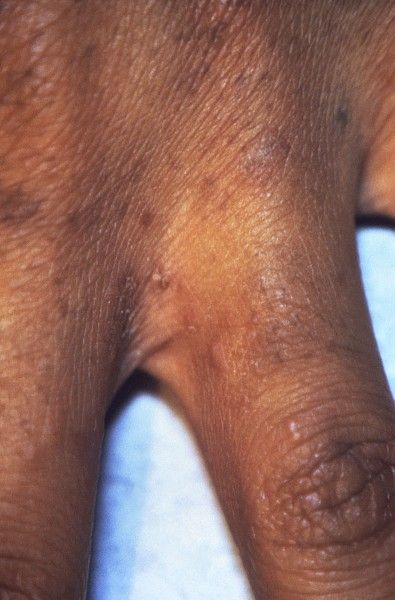Human scabies is an intensely pruritic skin infestation caused by the host-specific mite Sarcoptes scabiei var hominis. Scabies is a global public health problem, affecting persons of all ages, races, and socioeconomic groups. Worldwide, an estimated 300 million cases occur annually. Overcrowding, delayed diagnosis and treatment, and poor public education contribute to the prevalence of scabies in industrial and developing nations. While it is easily treatable, scabies remains common because of the difficulty in diagnosis, the inadequate treatment of patients and their contacts, and improper concurrent environmental control measures to eradicate the mites. Scabies is a great clinical imitator, and because of this, its symptoms and cutaneous manifestations often result in a delayed diagnosis.
MODE OF TRANSMISSION
Direct skin-to-skin contact is the main mode of transmission of scabies, and as such, scabies has been considered a sexually transmitted disease. The mite does not penetrate deeper than the superficial layer of the epidermis, the stratum corneum. It is important to note that a person infested with mites can spread scabies even if he/she is asymptomatic. There may be a prolonged interval of up to ten weeks between the primary infection and the onset of clinical manifestations, but during this time the patient is contagious. Scabies is less frequently transmitted by indirect contact through fomites such as infested clothing or bedding or clothing. However, the greater the number of parasites on a person, as in crusted scabies, the more likely that indirect contact will transmit the disease.
It is the female Sarcoptes scabiei var hominis mite that infects humans. It is 0.3-0.4 mm long, which is large enough for it to be seen with the naked eye. The mite has 4 pairs of legs and crawls at a rate of 2.5 cm/minute. It cannot fly or jump. Although its life cycle occurs completely on the host, the mite is able to live on bedding, clothes, or other surfaces at room temperature for 2-3 days, while remaining capable of infestation and burrowing. At temperatures below 20°C, S scabiei are immobile, although they can survive such temperatures for extended periods.
LIFE CYCLE OF THE SCABIES MITE
The scabies mite is an obligate parasite, which means that it completes its entire life cycle on humans. Some types of the scabies mite can cause infestation in other mammals, such as dogs, cats, pigs, ferrets, and horses, but they are unable to reproduce in humans. These mites may still be irritating to human skin and cause a transient dermatitis.
The female Sarcoptes scabiei var hominis mite has a 60-90 day lifecycle. During this time, she lays 60-90 eggs, although less than 10% of the eggs result in mature mites. The average patient is infected with 10-15 live adult female mites at any given time.
Life cycle stages are as follows:
- Eggs incubate and hatch in 3-4 days – 90% of the hatched mites die.
- Larvae (3 pairs of legs) migrate to the skin surface and burrow into the intact stratum corneum to make short burrows, called molting pouches (3-4 days)
- Larvae molt into nymphs (4 pairs of legs), which molt once into larger nymphs before becoming adults
- Mating takes place once, and the female is fertile for the rest of her life; the male dies soon after mating
- The female makes a serpentine burrow using proteolytic enzymes to dissolve the stratum corneum of the epidermis, laying eggs in the process; she continues to lengthen her burrow and lay eggs for the rest of her life, surviving 1-2 months
- Transmission of impregnated females from person-to-person occurs through direct or indirect skin contact
CLASSIC SCABIES
In classic scabies infection, typically 10-15 mites live on the host. During the first month, there is little evidence of infection, but after four weeks and with subsequent infections, the host experiences a delayed type hypersensitivity reaction to the mites, eggs, and scybala (feces). It is believed that the four-week asymptomatic latent period is the time in which the body induces an immunity to the primary infection. Then, with reinfestation from the subsequent generation, the sensitized individual may develop a rapid reaction that occurs within hours. The resultant skin eruption and its associated intense pruritus are the hallmarks of classic scabies.
CRUSTED SCABIES
Crusted, or Norwegian, scabies (so named because the first description was from Norway in the mid-1800s) is a distinctive and highly contagious form of the disease. In this disease, hundreds to millions of mites infest the host individual, who is usually immunocompromised, elderly, or physically or mentally disabled and impaired.
Individuals that become infected with Norwegian scabies should have an assessment of their immune function. Crusted scabies can be easily confused with severe dermatitis or psoriasis because widespread, crusted lesions appear with thick, hyperkeratotic scales over the elbows, knees, palms, and soles. The diagnosis of crusted scabies should be considered when suspected dermatitis or suspected psoriasis does not respond to usual treatments.
In our next post, we will discuss the ectoparasite Lice, and in our third post of this Ectoparasite series, the potential treatment for ectoparasites and patient education for the patient with an ectoparasite infection will be discussed.
**This Ectoparasite series is based upon The Correctional Nurse Educator class, Ectoparasites in the Correctional Environment.
Please share your challenges with the care of patients with an ectoparasite infestation in the comments section below.
